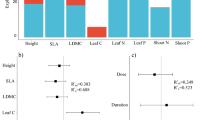Abstract
This study tested whether differences in species abundance at an infertile site could be explained by differences in the species' plant traits. Nine traits were chosen for the analysis based on results of previous studies conducted across soil fertility gradients. The traits were measured for each of seven herbaceous species whose abundance ranged from 5% to 100% of locations occupied in a ridgetop habitat. Using linear regression, significant relationships were found between species relative abundance and each of five traits. In these relationships, a trait explained between 69% and 88% of interspecific variation in abundance. Relatively abundant species had a slower growth rate, smaller shoot mass, higher root to shoot ratio, slower loss of leaf tissue to herbivores and higher infection of roots by mycorrhizal fungi than less abundant species. Using three of these five traits (i.e. shoot mass, mycorrhizal infection and loss of leaf tissue to herbivores) as independent variables in a multiple regression equation explained 99% of interspecific variation in abundance. The latter result indicates that species relative abundance can be explained for a single habitat by choosing traits found to be related to species abundance in previous gradient studies. However, not every trait chosen was significantly related to species abundance. Therefore, a large number of traits may have to be chosen initially to ensure that some subset of these traits can explain species relative abundance.
Similar content being viewed by others
References
Berendse, F. & Elberse, W. T. 1989. Competition and nutrient loss from the plant. Pp. 269–284. In: Lambers, H., Cambridge, M. L., Konings, H. & Pons, T. L. (eds). Causes and consequences of variation in growth rate and productivity of higher plants. SPB Academic Publishing, The Hague.
Brundrett, M., Melville, L. & Peterson, R. L. 1994. Practical methods in mycological research. Mycologue Publications, Victoria, Australia.
Chapin, F. S. III. 1980. The mineral nutrition of wild plants. Annual Review of Ecology and Systematics 11: 233–260.
Chapin, F. S. III. 1988. Ecological aspects of plant mineral nutrition. Adv. in Plant Nutr. 3: 161–191.
Duarte, C. M., Sand-Jensen, K., Nielsen, S. L., Enriquez, S. & Agusti, S. 1995. Comparative functional plant ecology: rationale and potentials. Trends Ecol. Evol. 10: 418–421.
Duralia, T. E. & Reader, R. J. 1993. Does abundance reflect competitive ability?: a field test with three prairie grasses. Oikos 68: 82–90.
Epp, G. A. & Aarssen, L. W. 1989. Predicting vegetation patterns from attributes of plant growth in grassland species. Can. J. Bot. 67: 2953–2959.
Fitter, A. H., Nichols, R. & Harvey, M. L. 1988. Root system architecture in relation to life history and nutrient supply. Functional Ecol. 2: 345–351.
Gleason, H. A. & Cronquist, A. 1991. Manual of vascular plants of northeastern United States and adjacent Canada. 2nd edition. New York Botanical Garden, New York.
Gower, S. T., Pongracic, S. & Landsberg, J. J. 1996. A global trend in belowground carbon allocation: can we use the relationship at smaller scales? Ecology 77: 1750–1755.
Grime, J. P. 1979. Plant strategies and vegetation processes. John Wiley & Sons, Chichester, UK.
Grubb, P. J., Kelly, D. & Mitchley, J. 1982. The control of relative abundance in communities of herbaceous plants. Pp. 79–97. In: Newman, E. I. (ed.). The plant community as a working mechanism. Blackwell Scientific Publications, Oxford, UK.
Keddy, P. A. 1992. A pragmatic approach to functional ecology. Functional Ecol. 6: 621–626.
Mamolos, A. P., Veresoglou, D. S. & Barbayiannis, N. 1995. Plant species abundance and tissue concentrations of limiting nutrients in low-nutrient grasslands: a test of competition theory. J. Ecol. 83: 485–495.
Mitchley, J. 1990. Control of relative abundance of perennial dicotyledons in chalk grassland. Pp. 67–73. In: Hillier, S. H., Walton, D. W. H. & Wells, D. A. (eds.). Calcareous grassland ecology and management. Bluntisham Books, Huntingdon, UK.
Moore, D. R. J. & Keddy, P. A. 1989. The relationship between species richness and standing crop in wetlands: the importance of scale. Vegetatio 79: 99–106.
Page, A. L., Miller, R. H. & Keeney, D. R. 1982. Methods of soil analysis. Part II. Chemical and microbiological properties. Amer ican Society of Agronomy, Soil Science of America, Madison, Wisconsin.
Rabinowitz, D., Rapp, J. K., Cairns, S. & Mayer, M. 1989. The persistence of rare prairie grasses in Missouri: environmental variation buffered by reproductive output of sparse species. Am. Nat. 134: 525–544.
Reader, R. J. 1992. Herbivory as a confounding factor in an experiment measuring competition among plants. Ecology 73: 373–376.
Reader, R. J. & Watt, W. H. 1981. Response of hawkweed (Hieracium floribundum) patches to NPK fertilizer in an abandoned pasture. Canadian Journal of Botany 59: 1944–1949.
Rees, M. 1995. Community structure in sand dune annuals: is seed weight a key quantity? J. Ecol. 83: 857–863.
Reich, P. B. 1993. Reconciling apparent discrepancies among studies relating life span, structure and function of leaves in contrasting life forms and climates: 'the blind men and the elephant retold'. Funct. Ecol. 7: 721–725.
SAS Institute. 1988. SAS/STAT user's guide, release 6.03 edition. SAS Institute Inc. Cary, NC.
Theodose, T. A., Jaeger, C. H. III, Bowman, W. D. & Schardt, J. C. 1996. Uptake and allocation of 15N in alpine plants: implications for the importance of competitive ability in predicting community structure in a stressful environment. Oikos 75: 59–66.
Thomas, R. L., Sheard, R. W. & Moyer, J. R. 1967. Comparison of conventional and automated procedures for N, P and K analysis of plant material using a single digestion. Agron. J. 59: 240–243.
Tilman, & Wedin, D. 1991. Plant traits and resource reduction for five grasses growing on a nitrogen gradient. Ecology 72: 685–700.
Author information
Authors and Affiliations
Rights and permissions
About this article
Cite this article
Reader, R.J. Relationship between species relative abundance and plant traits for an infertile habitat. Plant Ecology 134, 43–51 (1998). https://doi.org/10.1023/A:1009700100343
Issue Date:
DOI: https://doi.org/10.1023/A:1009700100343




